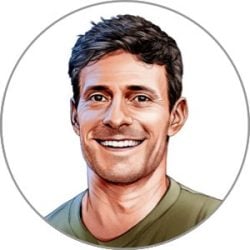Pane Siciliano is a traditional bread from Sicily made with durum wheat (semolina), sometimes a little olive oil (as I do in this recipe), and even sweeteners such as honey or barley malt syrup. The flavor is nutty, sweet, and with a buttery mouthfeel, thanks to the olive oil. The sesame seeds densely coating the exterior bring a peanut butter-like flavor and nuttiness that I find irresistible.
I was nervous when I started testing this Pane Siciliano bread recipe.
I was nervous when I started testing this pane Siciliano bread recipe. I’ve baked often with durum wheat, but I usually mix it with modern wheat to get the best of both worlds: a golden crumb and crust from the durum, as well as loft and openness from modern wheat. But instead of following the same path, I decided to go all-in and make a traditional Sicilian-style bread using 100% durum.
The resulting bread is a little different than what you usually see here at The Perfect Loaf. It doesn’t have a dramatic single slash across the top (like my best sourdough recipe), deep mahogany colors, and, most noticeably, an airy interior (the crumb is very tight)r. But the good news is, the loaf is everything I had hoped it would be and more.
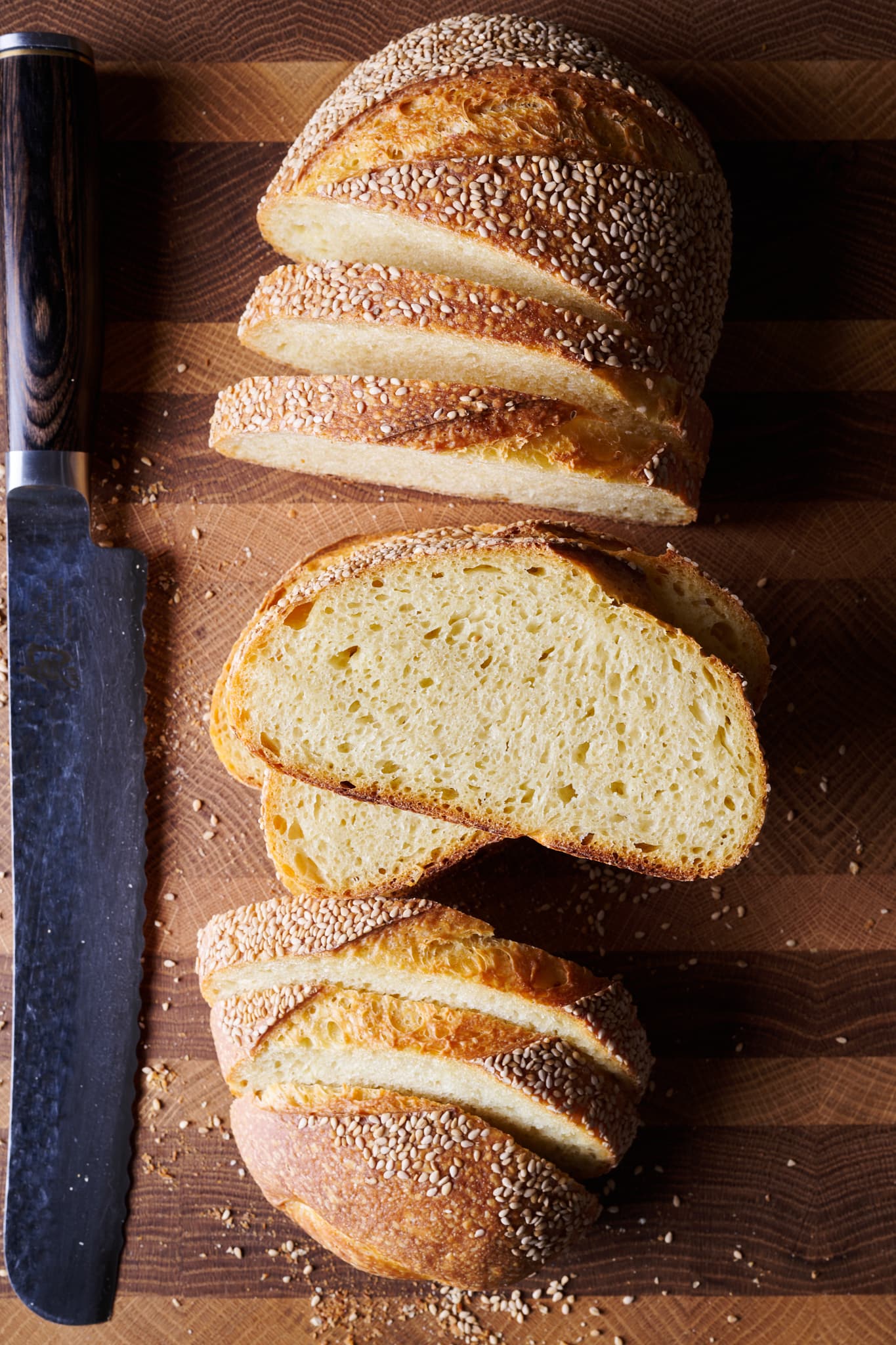
When heavily toasted, slices of this bread take on a new dimension. The flavor of the sesame seeds is amplified, the crust turns wonderfully brittle, and the crumb shifts from golden to straight-up resplendent. This is the same reason I use durum flour in my pizza dough: the crispness and crunch that develop when exposed to high heat are delectable.
Durum flour
This pane Siciliano is made with 100% durum wheat semolina. For the best results, be sure to use durum that’s labeled “extra fancy” or “semolina rimacinata” (which means twice-milled semolina). This durum wheat is milled incredibly fine and performs the best in bread doughs.
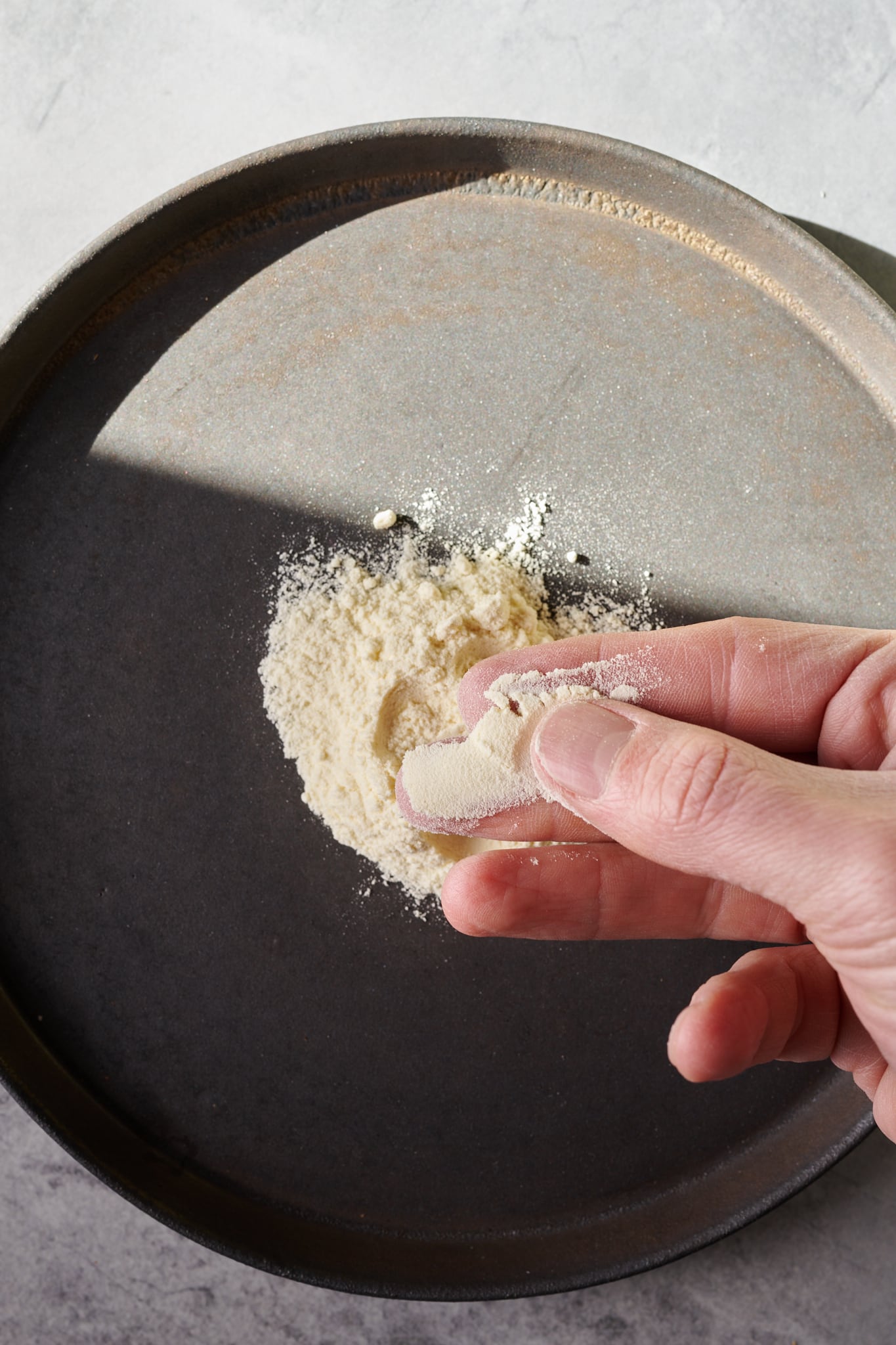
If you have semolina (typically used for pasta), which is coarsely milled durum wheat, feel free to try the recipe and experiment. Note that the dough will likely be stickier, resulting in a loaf with a more closed crumb, but the flavor and texture in the final bread will still be fantastic.
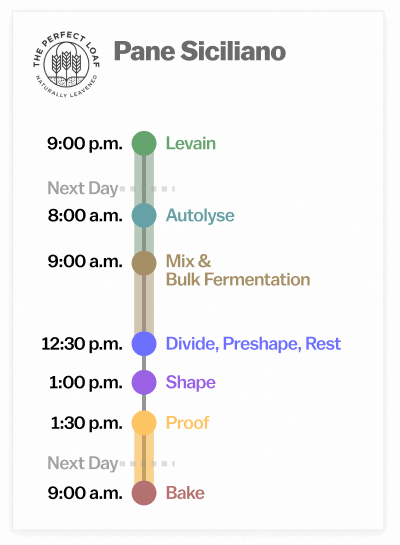
I source my durum flour from Central Milling (get their “Organic Pasta Flour”) and Flourist.
See my comprehensive guide to durum flour for selecting the right flour for bread (or pasta).
Baking Schedule
This pane Siciliano is made over two days for increased flavor and a convenient baking schedule for baking at home. However, it’s possible to make this bread all in a single day—direct method—by allowing the dough to proof on the counter, shaped and covered, until the dough is puffy, relaxed, and passes the dough poke test.
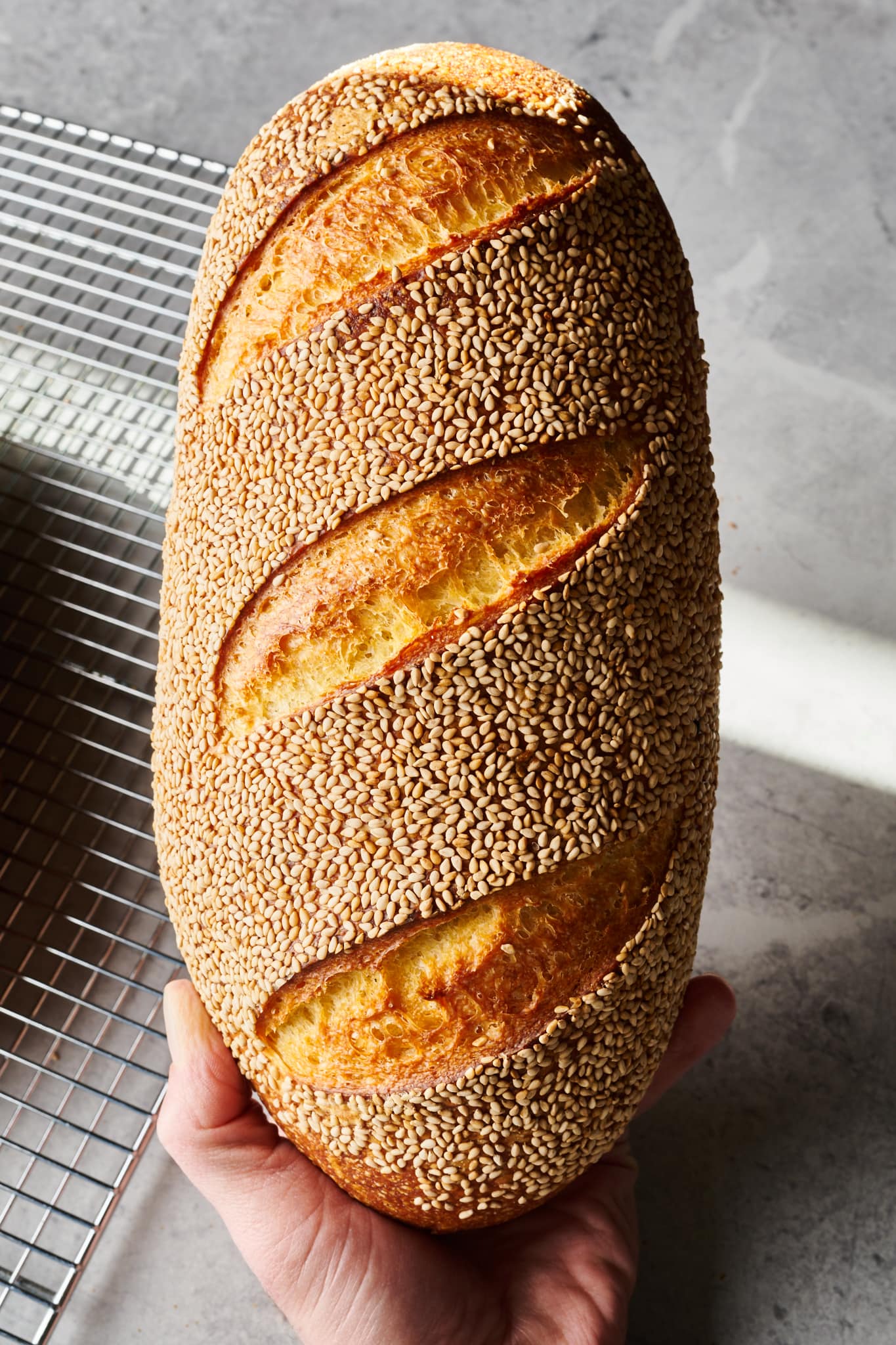
Pane Siciliano Recipe
For tips on calculating baker’s percentages or modifying this formula, see my post on baker’s percentages (baker’s math).
Vitals
| Total dough weight | 1,800 grams |
| Prefermented flour | 11.0% |
| Levain in final dough | 21.0% |
| Hydration | 75.0% |
| Yield | Two 900g loaves |
Total Formula
Desired dough temperature: 78°F (25°C) (see my post on the importance of dough temperature).
| Weight | Ingredient | Baker’s Percentage |
|---|---|---|
| 991g | Durum flour, finely milled (“durum extra fancy”) | 100.0% |
| 35g | Extra-virgin olive oil | 3.5% |
| 694g | Water 1 (levain and autolyse) | 70.0% |
| 50g | Water 2 (mix) | 5.0% |
| 20g | Fine sea salt | 2.0% |
| 11g | Ripe sourdough starter, 100% hydration | 1.1% |
Additional ingredients
White sesame seeds, for topping (these are my favorite sesame seeds)
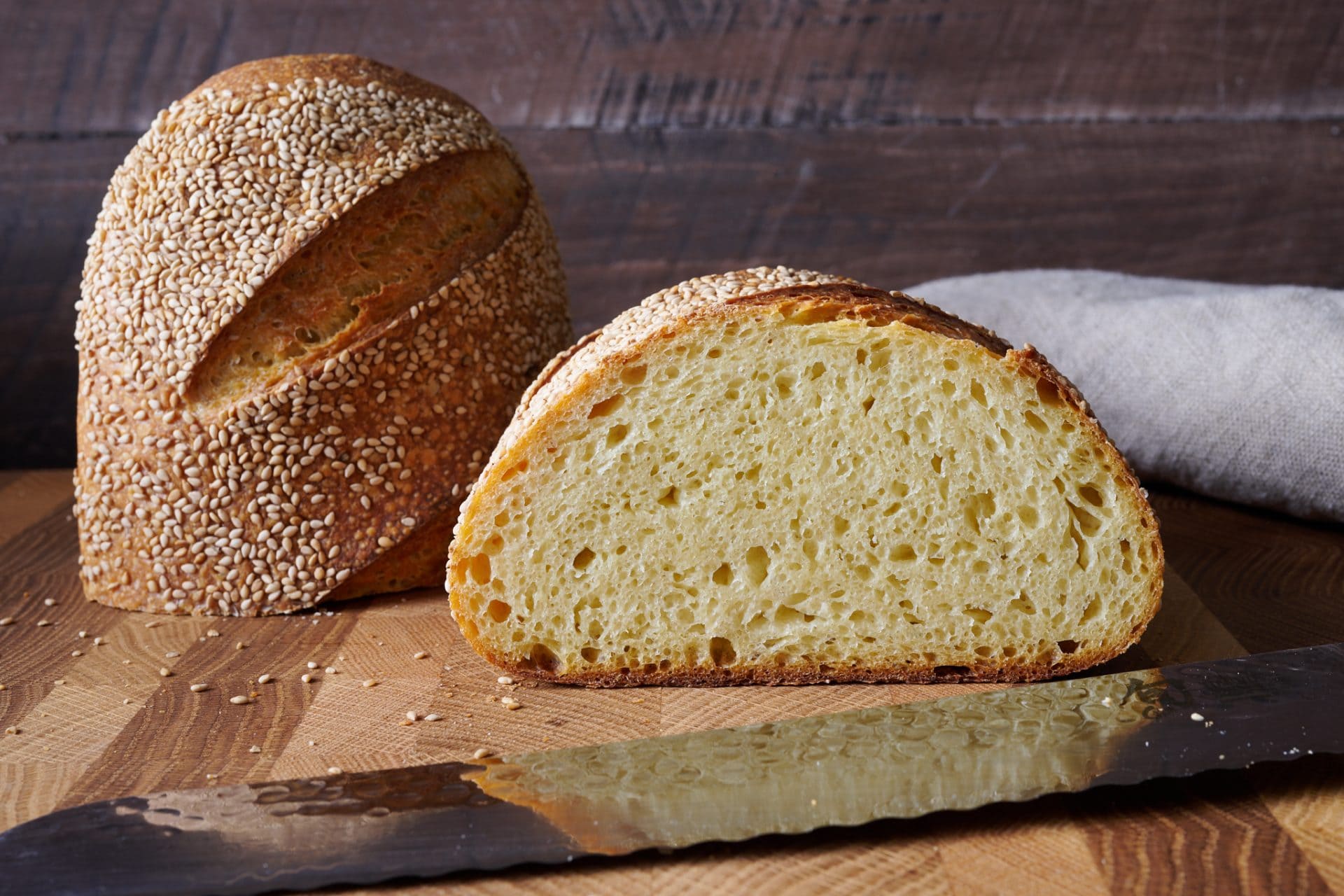
Pane Siciliano Method
1. Prepare the stiff levain – 9:00 p.m.
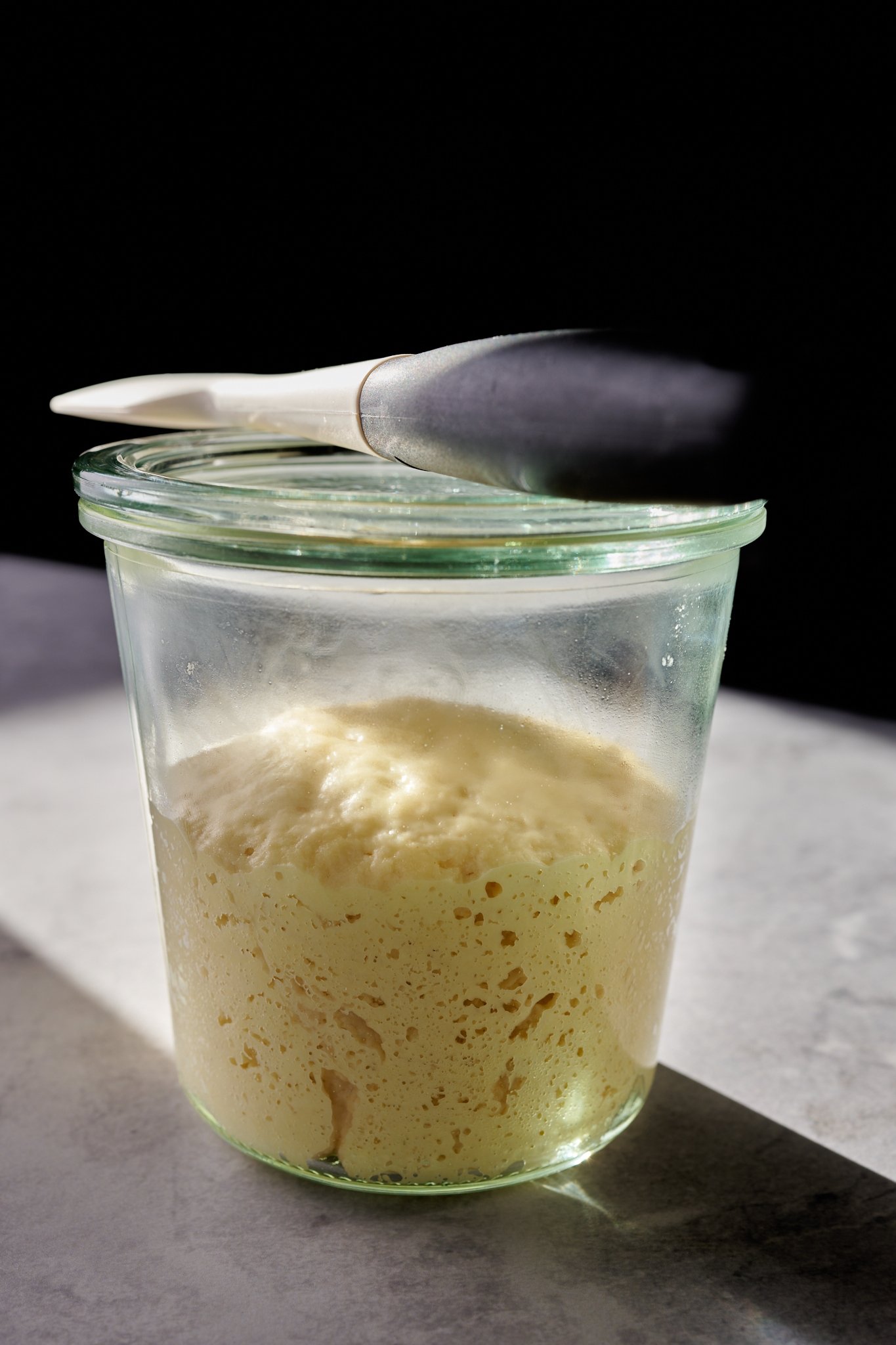
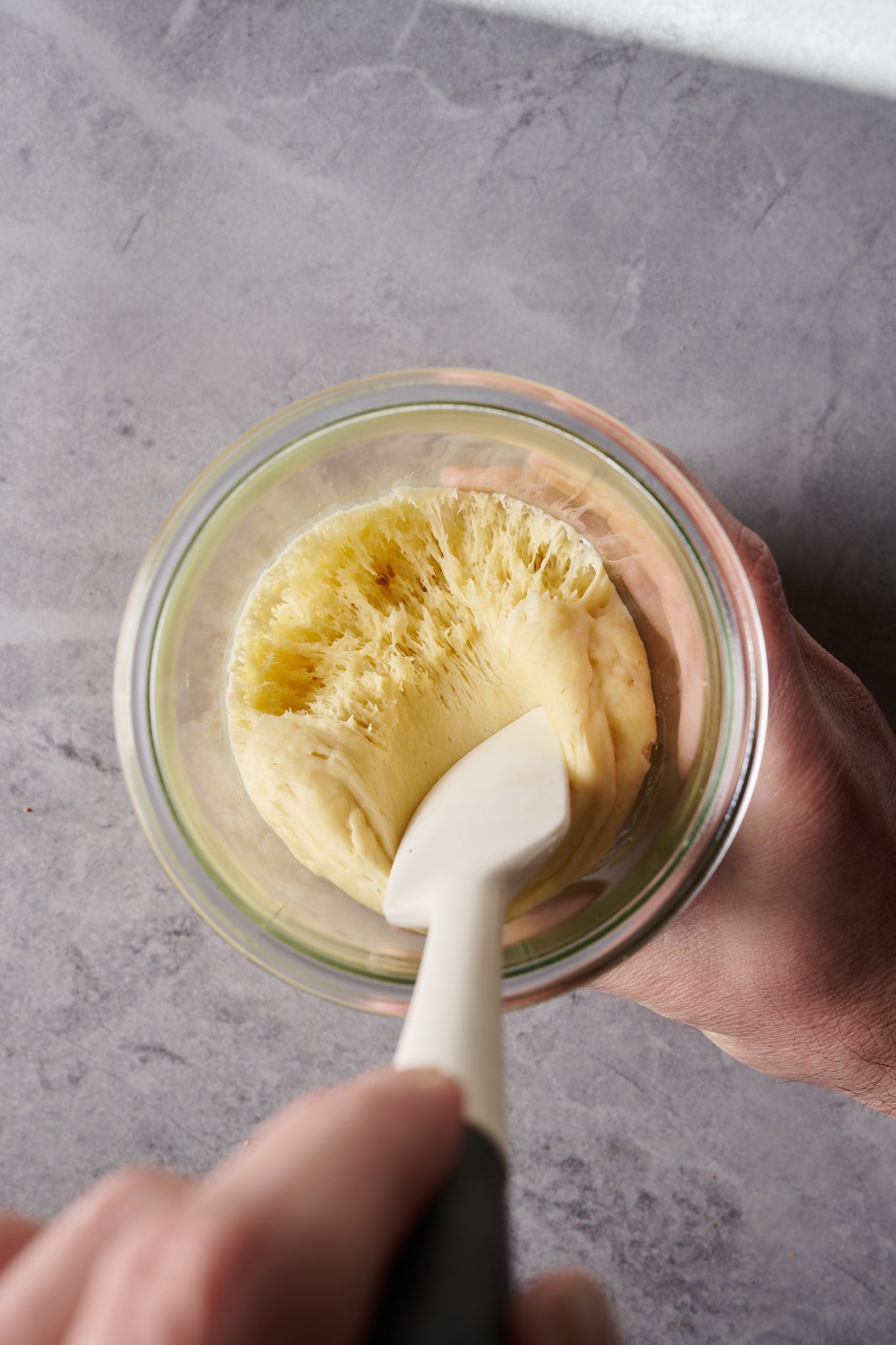
| Weight | Ingredient | Baker’s percentage |
| 109g | Durum flour | 100.0% |
| 65g | Water 1 (levain) | 60.0% |
| 11g | Ripe sourdough starter, 100% hydration | 10.0% |
Mix the ingredients in the chart above in your favorite jar and leave them covered at a warm temperature, 74-76°F (23-24°C), to ripen overnight. This is a stiff levain; if it is exceedingly hard to knead the ingredients together, use a little more water to make incorporation easier.
2. Autolyse – 8:00 a.m.
| Weight | Ingredient |
| 882g | Durum flour |
| 628g | Water 1 (autolyse) |
I use the autolyse technique for this recipe to help reduce the total mixing time required, but I also find it helps aid in the dough’s extensibility when using durum flour.
Warm or cool the autolyse water so that the temperature of the mixed dough meets the final dough temperature (FDT) of 78°F (25°C) for this recipe. Place the flour and water 1 in a large bowl. Use wet hands to mix until no dry bits remain; the dough will be shaggy and loose. Use a bowl scraper to scrape down the sides of the bowl to keep all the dough in one area at the bottom. Cover the bowl and place it near your levain for 1 hour.
3. Mix – 9:00 a.m.
| Weight | Ingredient |
| 35g | Extra-virgin olive oil |
| 50g | Water 2 (mix) |
| 20g | Fine sea salt |
| 185g | Ripe levain (from Step 1) |
Add the salt and levain to the top of the dough in autolyse and use a splash of water 2 to moisten. With wet hands, mix thoroughly. Durum tends to feel incredibly sticky when mixing. Use wet hands or a dough whisk to help make mixing easier. Add the remaining water if the dough feels like it can handle it.
Next, knead the dough for a few minutes using either the slap and fold technique or folds in the bowl. For this dough, I kneaded for about 5 minutes until the dough smoothed and became elastic. Transfer the dough back into the bowl.
Spread the olive oil over the top and pinch it into the dough. Mix the oil into the dough by folding it up and over for 3 to 4 minutes. Once the oil is thoroughly mixed into the dough, transfer the dough to a bulk fermentation container and cover.
4. Bulk Fermentation – 9:30 a.m. to 12:30 p.m. (3 hours)
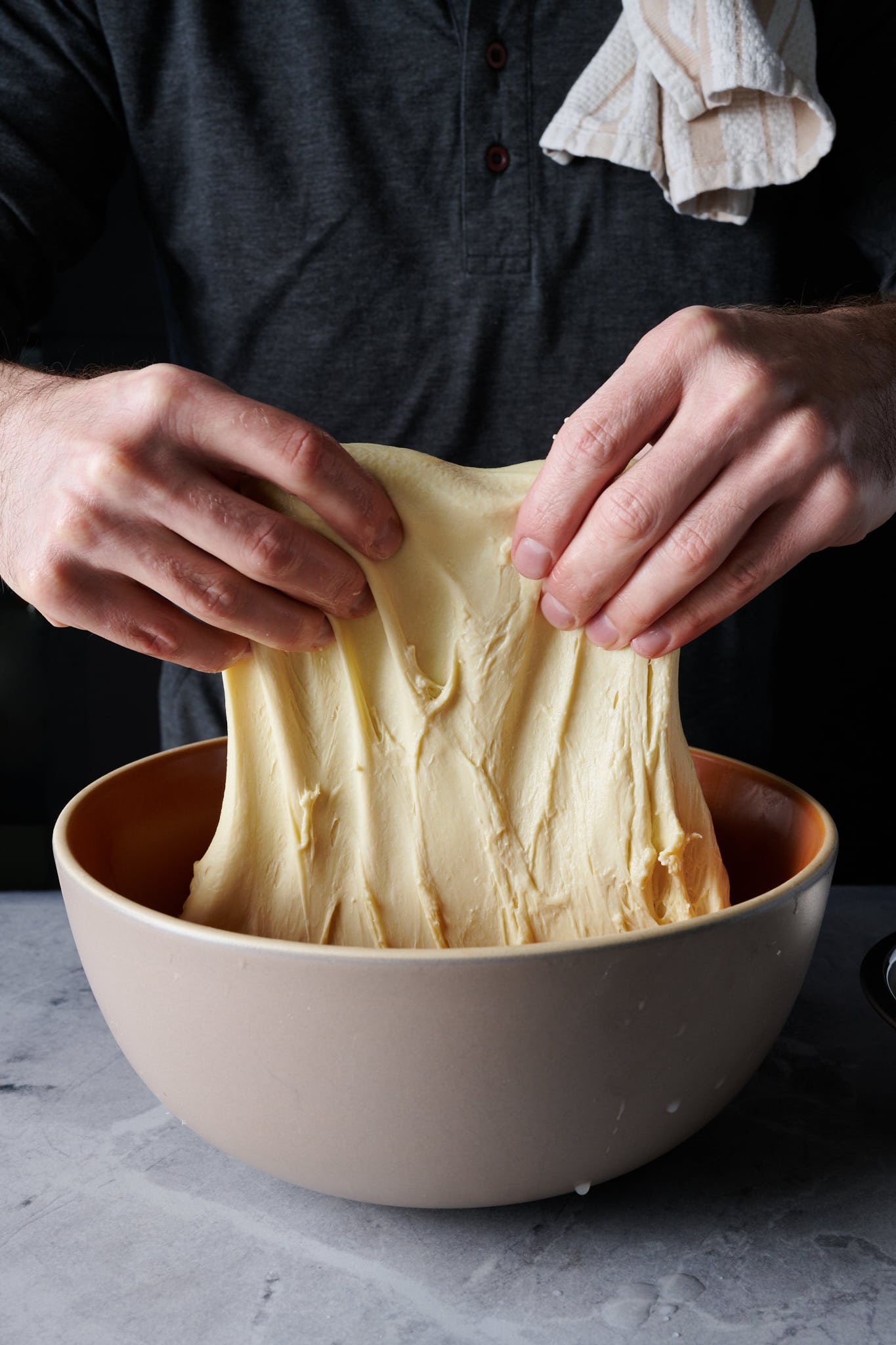
At a warm room temperature, 74-76°F (23-24°C), bulk fermentation should take about 3 hours.
This dough will require 2 sets of stretches and folds during bulk fermentation. After the first 30 minutes, wet your hands, grab the side of the dough farthest from you, and stretch it over to the other side. Rotate the bowl 180 degrees and repeat. Then rotate the bowl a quarter turn and stretch and fold that side. Rotate the bowl 180 degrees again and finish with a stretch and fold on the last side. The dough should be neatly folded up in the bowl. Cover and repeat these folds every 30 minutes for 2 sets of stretches and folds. Then let the dough rest, covered, for the remainder of bulk fermentation.
5. Divide and Preshape – 12:30 p.m.
After 3 hours, the dough should be well-risen and puffy in the bulk fermentation container. Durum flour will sometimes show little holes scattered on top of the dough; don’t worry about them.
Fill a small bowl with water and place it next to your work surface. Scrape the dough onto a clean counter and divide it into two equal pieces. With one wet hand and a bench knife in the other, preshape the pieces of dough into loose rounds.
Let the dough rest, uncovered, for 30 minutes.
6. Shape – 1:00 p.m.
Place a baking sheet or clean kitchen towel next to your work surface and spread an even layer of white sesame seeds on top.
Flour the top of the preshaped round and your work surface. Using your bench knife, flip one of the rounds over onto the floured area. Using floured hands, shape the dough into a bâtard. Transfer the shaped dough, seam-side up, to the pan with sesame seeds and rock it back and forth so the seeds stick.
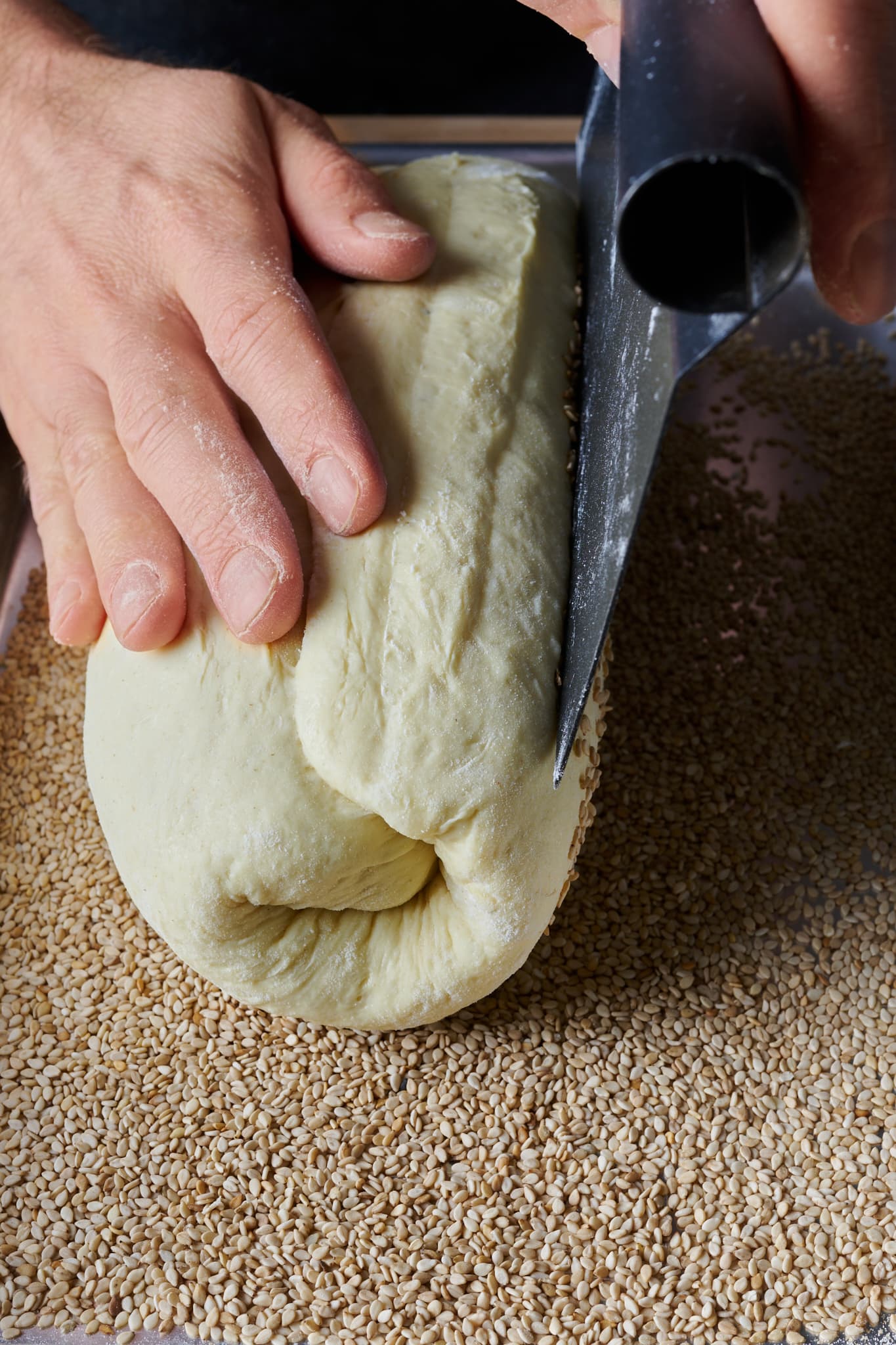
Gently transfer the dough to an 11-inch long proofing basket, seam-side up. Repeat with the remaining round.
See my guide to topping bread dough for more instructions (and topping inspirations).
7. Proof – 1:30 p.m. to 9:00 a.m.
Cover the baskets with a large, reusable plastic bag and seal shut. Place the baskets in the refrigerator to proof overnight.
8. Bake – 9:00 a.m.
Place an oven rack with a baking surface on top in the bottom-third of the oven. Preheat the oven to 450°F (230°C) for 30 minutes. Due to the oval shape of these loaves, I prefer to bake them directly on a baking surface and steam my oven. See my guide to steaming a home oven for bread baking for instructions.
Take one of the proofing baskets out of the fridge, uncover it, and put a piece of parchment paper over the basket. Place a pizza peel or inverted baking sheet on top of the parchment, and using both hands, flip everything over. Gently remove the basket and score the dough. Repeat with the other basket.
Below, you can see my using my clever Wire Monkey UFO baker’s lame, which is perfect for scoring at a 90° angle to the dough.
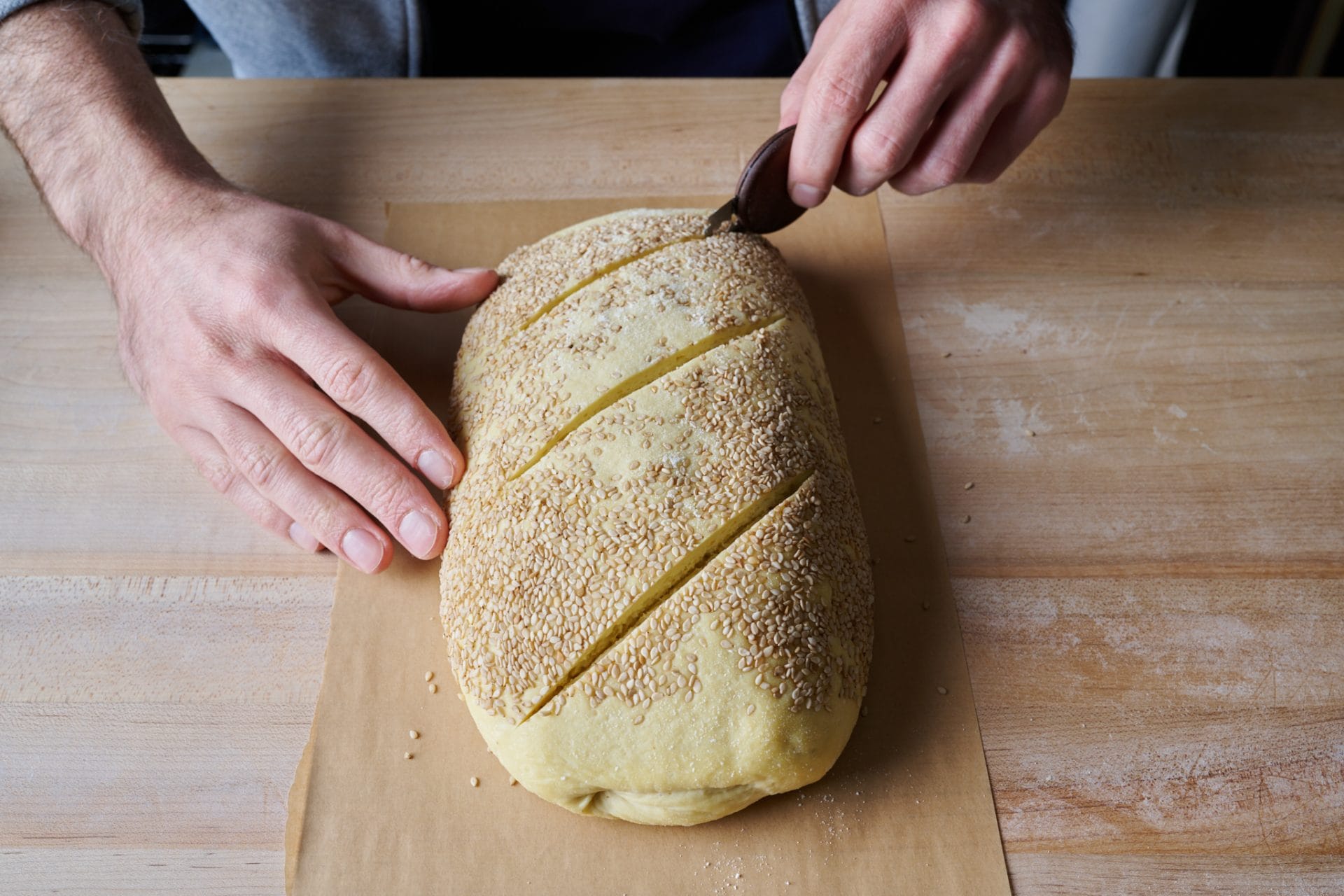
Slide the dough into the oven, side by size. Steam the oven by pouring ice into the preheated pan at the bottom of the oven. Bake for 20 minutes. Vent the oven of steam by removing the steaming pans. Continue to bake for 35 minutes more. When done, the loaf should have an internal temperature of around 204°F (95°C), and the crust should be golden-colored. Let the loaves cool on a wire rack for 1 to 2 hours before slicing with your favorite bread knife.
This pane Siciliano will keep well for a week or more when stored properly.
Print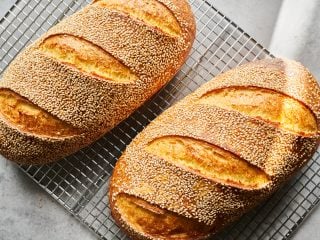
Pane Siciliano (Semolina and Sesame Sourdough Bread)
- Author: Maurizio Leo
- Prep Time: 23 hours
- Cook Time: 1 hour
- Total Time: 24 hours
- Yield: 2 loaves
- Category: Main course
- Cuisine: Italian
Description
Pane Siciliano is a traditional bread from Sicily made with durum wheat (semolina), sometimes a little olive oil (as I do in this recipe), and even sweeteners such as honey or barley malt syrup. The flavor is nutty, sweet, and with a buttery mouthfeel, thanks to the olive oil. The sesame seeds densely coating the exterior bring a peanut butter-like flavor and nuttiness that I find irresistible.
Ingredients
Levain
- 109g durum flour
- 65g water
- 11g ripe sourdough starter (100% hydration)
Autolyse
- 882g durum flour
- 628g water
Main Dough
- 35g extra-virgin olive oil
- 50g water
- 20g fine sea salt
- 185g ripe levain
Instructions
- Levain (9:00 p.m.)
In a small bowl mix the Levain ingredients. Cover the jar and keep it at a warm temperature overnight. - Autolyse (8:00 a.m)
In a mixing bowl, add the Autolyse ingredients until no dry bits remain. Cover the bowl and let rest for 1-hour. - Mix (9:00 a.m.)
Add the salt and levain to the top of the dough in autolyse and use a splash of the remaining water to moisten. With wet hands, mix thoroughly. Add the remaining water if the dough feels like it can handle it. Knead the dough for a few minutes using either the slap and fold technique or folds in the bowl until the dough smooths and becomes elastic. Transfer the dough back into the bowl. Spread the olive oil over the top and pinch it into the dough. Mix the oil into the dough by folding it up and over for 3 to 4 minutes. Transfer the dough to a bulk fermentation container and cover. - Bulk Fermentation (9:30 a.m. to 12:30 p.m.)
This dough will require 2 sets of stretches and folds during bulk fermentation at 30-minute intervals. After the second set, let the dough rest, covered, for the remainder of bulk fermentation. - Divide and Preshape (12:30 p.m.)
Scrape the dough out to a clean work surface. Use water and a wet hand, and your bench knife, divide the dough in half. Lightly shape each half into a round shape and let rest for 30 minutes, uncovered. - Shape (1:00 p.m.)
Place a baking sheet or clean kitchen towel next to your work surface and spread an even layer of white sesame seeds on top. Flour the top of the preshaped round and your work surface. Using your bench knife, flip one of the rounds over onto the floured area. Using floured hands, shape the dough into a bâtard. Transfer the shaped dough, seam-side up, to the pan with sesame seeds and rock it back and forth so the seeds stick. Gently transfer the dough to an 11-inch long proofing basket, seam-side up. Repeat with the remaining round. - Proof (1:30 p.m. to 9:00 a.m. the next day)
Cover proofing baskets with reusable plastic, seal, and place into the refrigerator overnight. - Bake (The next day, 9:00 a.m.)
Place an oven rack in the bottom-third of the oven with a baking surface on top and preheat to 450°F (230°C). Take one of the proofing baskets out of the fridge, uncover it, and put a piece of parchment paper over the basket. Place a pizza peel or inverted baking sheet on top of the parchment, and using both hands, flip everything over. Remove the basket and score the dough. Repeat with the other basket. Slide the dough into the oven, side by size. Steam the oven by pouring ice into the preheated pan at the bottom of the oven. Bake for 20 minutes. Vent the oven of steam by removing the steaming pans. Continue to bake for 35 minutes more. When done, the loaf should have an internal temperature of around 204°F (95°C), and the crust should be golden-colored. Let the loaves cool on a wire rack for 1 to 2 hours before slicing.
Notes
The extra-virgin olive oil can be left out of this recipe with no other changes.
Pane Siciliano FAQs
Can I use semolina flour instead of durum flour for this bread?
Yes, you can. Semolina is more coarsely milled durum wheat, so expect slightly less baking performance, though the final loaf will still have a nice rise and fantastic flavor.
Can I leave out the olive oil for this Pane Siciliano?
Yes, you can leave out the olive oil altogether (there’s no need to add water in its place).
What’s Next?
For another recipe using durum wheat (semolina, in this case), look at my Seeded Sourdough, which incorporates a large seed soaker directly into the dough. Or, for a super crunchy snack, make my Italian-style rusks, Sourdough Friselle.
Buon appetito!




